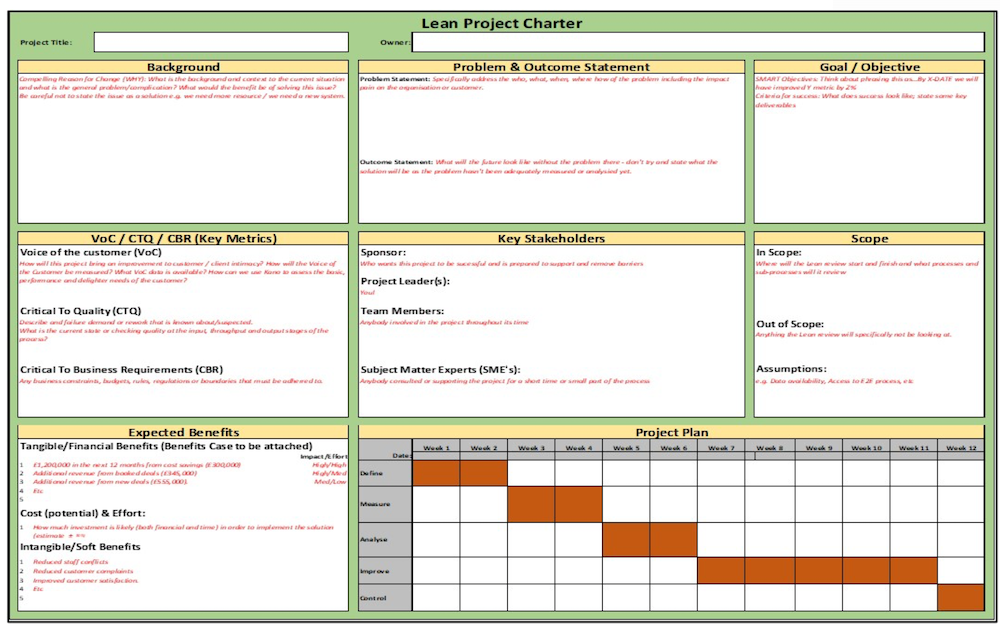To complement our series of QuickReads covering measurement, we will now explore Failure Demand (FD).…

ChangeWise Quick Read: How to Write a Winning Lean Charter
In this Quick Read, we take a look at how to write a simple Lean Charter. We will cover what you need to include and how to capture the information in a concise and informative way.

What is the purpose of the Lean Charter?
The Lean Charter is created at the outset of the Lean review, in the mobilisation phase. It is a high-level (one page) document that offers information on the Lean assessment including; Background, Problem & Outcome Statement, Goal/Objectives, Key Metrics, Key Stakeholders, Scope, Expected Benefits and a basic Project Plan outlining the planned delivery phases.
Why do I need a charter? I know what I need to do and I just want to get started…..
We think it’s great that you’re raring to go – but no person is an island! To ensure your Lean review is as successful as it possibly can be, you will need support from key stakeholders and subject matter experts. It is really important that anyone who might be impacted or need to help you with the review understands exactly what is in scope, why you are looking at it and what you expect to gain from the review.
Oh ok, I get it! More details please……
Of course! Let’s look at each section in turn using an example of a lean review taking place within a Learning & Delivery Team to help us.
1: Background
This is where you add your compelling reason for change. Why are you looking at this particular process? What is the general problem or complication and what benefit do you expect to see?
For Example:
Training courses for new apprentices are not available for 4-8 weeks after on-boarding. During this time, new starters cannot complete work requests but are on payroll, resulting in significant financial loss. Courses are also half full but we pay per session, not per head. This also has additional implications such as reduced employee satisfaction and in some cases, losing apprentices to competitors. A full Lean review is required to fully understand the root causes and develop solutions.
⭐️ Top Tip! This section needs to be a statement and not a solution – you have not fully completed the analysis required to confirm the root cause and need to be careful not to make assumptions. Avoid statements such as ‘we need to change suppliers in order to address the training capacity levels’.
2: Problem & Outcome Statement
This is where you fully address the problem using 5 Whys + 1H (See our ChangeWise Quick Read: Creating the Perfect Problem and Outcome Statement for more details on this technique).
Problem statements are brief, specific descriptions that explain the process, what the problem is, how often it occurs, and what the impact is. They begin with ‘How can we improve the process of……..?’
Outcome statements respond to the problem statement and define the future state and targets for the team. They begin with ‘We will know we’ve been successful when…..?
For Example:
How can we improve the process of ‘onboarding to training completed’ for new apprentices in the South West region (currently a 4-8 week wait for training after onboarding, resulting in significant salary costs), and also improve the capacity of delegates attending training (currently at 50% capacity)?
We will know we have been successful when ‘onboarding to training completed’ is significantly reduced and training classes are running at near full capacity.
3: Goal/Objectives
What does success look like? Make sure your objectives are SMART.
For Example
Training courses available 2-5 days after onboarding by July 2023
Training classes running at 90% capacity by March 2023
Increased employee retention by 20% by January 2023
4: Key Metrics
This section considers key metrics, including:
4a – Voice of Customer (VoC) – How will this review improve Voice of Customer?
For Example
Increased employee satisfaction scores for new apprentices (measured week 1, 5 & 8)
Improved employee retention (reduction in apprentices leaving during weeks 1-8)
4b – Critical to Quality (CTQs) – What factors are considered critical to quality?
For Example
Courses are available by qualified, recognised suppliers on week one of on-boarding
4c – Critical Business Requirements (CBRs) – What Critical Business Requirements must be adhered to?
For Example
Courses are available by qualified, recognised suppliers that meet legal requirements outlined by any external governing bodies

5: Key Stakeholders
A stakeholder is any individual potentially impacted by the outcome of your Lean review. They will have an interest in the success of the review, and can be within or outside your organisation. Stakeholders are absolutely vital because they can have both a positive and negative influence on outcomes depending on the level of their support and any decisions that need to be made. Different types of stakeholders include:
The Sponsor: Who wants this project to be successful and is prepared to move barriers and help resolve issues?
For Example:
Mike Jones – Director, Human Resources for South West Region
The Lean Leader: Who will execute the Lean review, track progress, manage issues and ensure the benefits are delivered?
For Example:
Jodie Smith – Supervisor, Training Scheduling, Learning & Delivery for South West Region
Team Members: This can be anyone involved in the project delivery phase
For Example:
Lisa Doyle – Training Scheduling and Delivery
Jim Coombes – Supplier contracts
Jane Heels – Training and Compliance
Subject Matter Experts (SMEs): This is anyone who may need to support the project for a short time or offer advice/consultancy
For Example:
Ted Baker – Capacity Planning, Central Operations
Alison Gates – Risk and Compliance Team, Central
6: Scope
What is in scope as part of this review? Think carefully about where the process starts and stops, then list what is in and out of scope, along with any likely assumptions that might be critical to your success.
For Example:
In scope
High volume new apprentices for the South West region
Booking and scheduling of training
Out of scope
Apprentices in other regions, specialist apprentices (insurance, legal)
Training content
Other onboarding activities (i.e., contracts, payroll activities)
Assumptions
Capacity Planning will provide an overview of their central function as part of the Gemba exercise
Representatives from the Risk will be available to approve any changes to process
The outcome of this review will be assessed by other regions and act as a possible footprint for apprentice training
7: Expected Benefits
What are the expected benefits? Both tangible and intangible? You may not have exact figures at this stage, but include anything you do have.
For Example:
Tangible benefits
£700,000 savings per annum currently paid to staff who cannot complete jobs as they wait for training
£450,000 savings as a result if reduced number of training sessions due to improved delegate capacity
Intangible benefits
Increased employee satisfaction scores Current = 45% Desired = 80%
Improved employee retention Current = 65% Desired = 90%
8: Project Plan
Finally, include a high-level overview of when you expect to complete each of the DMAIC phases. A more detailed delivery plan will be available following the Measure phase.
⚠️ Remember! At this stage, you may not have all the answers – and this is ok. At the Define stage we are really trying to understand if there is an opportunity for improvement and who will need to be involved. As you move through the DMAIC process you will have a better understanding of the issues, potential solutions and the expected benefits.

In Summary
The Lean Charter is created at the outset of the Lean review, in the mobilisation phase. It is a high-level (one page) document that offers information on the work to be completed and formally authorises the review. The Charter covers key information that provides direction and purpose for key stakeholders and anyone else involved in the success of the assignment.
Want to know more? Get in touch with the ChangeWise team at info@changewise.co.uk
ChangeWise believes employee engagement is the foundation for successful Change. Training and coaching your people to use simple continuous improvement techniques will enable your organisation to continuously adapt and stay ahead in a constantly changing and challenging environment.
For updates and interesting Lean Change insights, connect with us on LinkedIn.



